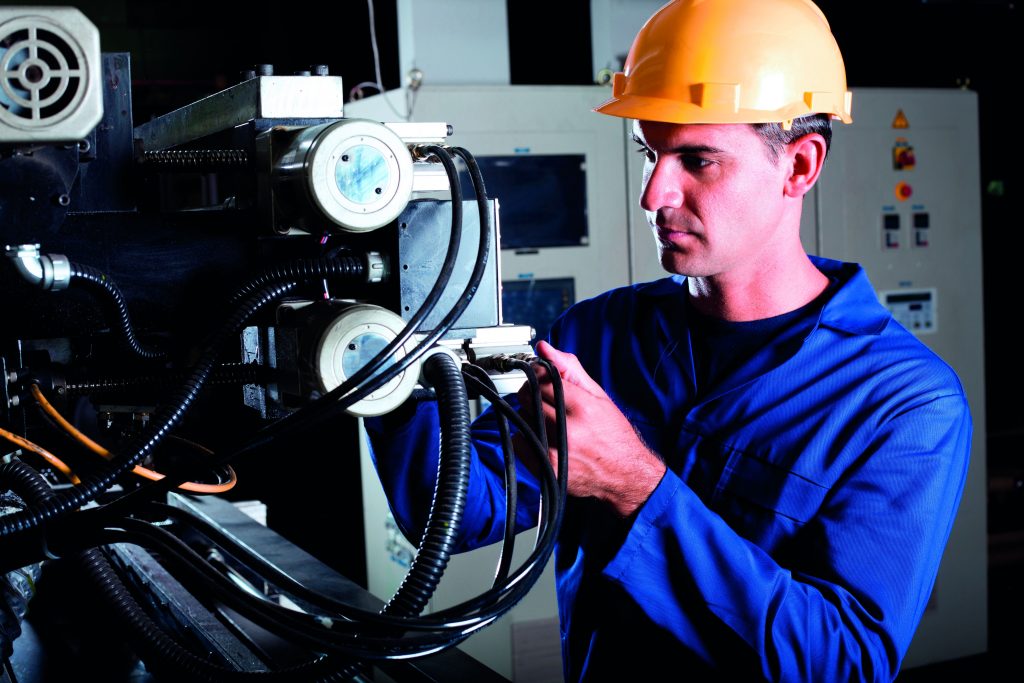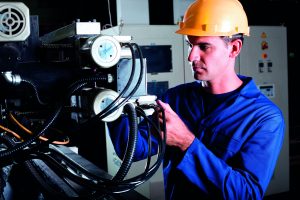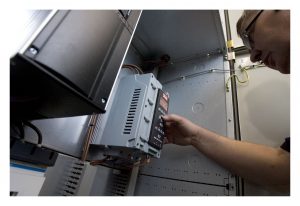
Retrofitting – Taking the next smart step with your VFD
November 13, 2017 | By Jonathan Mosterd
 With a product and a plan in place, the next step is to secure someone to perform the work. (http://drives.danfoss.us)
With a product and a plan in place, the next step is to secure someone to perform the work. (http://drives.danfoss.us) 
With a product and a plan in place, the next step is to secure someone to perform the work. (http://drives.danfoss.us)
As VFDs continue to inhabit the industrial and commercial landscapes around us, there comes a time when everyone realizes the finite lifecycle of their investment. Far too often this recognition happens during an unplanned failure or fault. Most experts in the field will agree that after 10 years of service, the average VFD with electrolytic capacitors is heading for the home stretch — when it will no longer be able to contain the smoke within it. Often people will ignore this truth or hope that good maintenance and possibly the odd repair will somehow stretch the life of their product. Yet there is a proactive approach that could help increase reliability, while saving money and time.
In being proactive, you can create plans to upgrade your equipment before it fails, based on calculated life expectancy. In fact, many VFD manufacturers and service organizations have created such programs to assist users and partner with them. These smart step programs seek to find cost-effective ways for owners to upgrade their equipment to newer models. The biggest benefit to being proactive is that you are given the time to come up with a plan. This plan can include a budget and allow you to invest in newer technologies. When a product fails unexpectedly, we are forced to become reactive. In doing so we spend more money and time and may not always get the product that we want installed. We become subject to whatever solution we can quickly locate and end up doing whatever we can to simply make it work. In creating a plan, you can reduce these unexpected costs and perform upgrades in a timely manner.
A good retrofit plan or program will seek ways to reduce costs, downtime and help to modernize your process. Instead of reacting to a problem, it’s possible to be proactive and have a chance to consider all options. This could include, for example, starting to plan or implement a new building control system or set up new communication protocols. Further, take the time to consider how the Internet of Things is affecting your business, or seek out ways to increase efficiency and product life. There are many reasons why spending time on this now will pay out dividends into the future.
One of the biggest reasons is to prevent unexpected failures, especially in a world of tight budgets and high production efficiencies. No one is happy when equipment fails in an unscheduled manner. Not only does upgrading give you an opportunity to make your process better, but it also provides you with confidence that the process will continue without interruption.
Knowing why it is important to plan for a retrofit is the first step. There are still the questions of who will do it, what product to install, where to install it, when to do it, and how it will be done. By addressing the classic who, what, where, when, why and how of the entire project, you can build a plan and business case and justify the upfront costs. Further, with proper planning you can spread these costs over a few years and thus reduce the overall budgetary costs.

A good retrofit program will allow one to be proactive instead of reactive. (http://drives.danfoss.us)
What. To start off a retrofit you need to define a preferred product. Often, the best way to do this is to step back in history and consider if the current drive product has met your needs or if it needs to be improved. One of the things to consider is the installation environment. Maybe you have a UL type 1 unit and, due to contamination, should investigate using a UL type 12 or type 4x instead. Other questions to consider are auxiliary components, such as contactors or sensors, which may also need to be updated. On top of this, newer VFDs often have some PLC functionality built in, so you may want to consider eliminating some smaller controllers or possibly adding functionality to existing systems. By taking time to talk with your local distributor, electrician or supplier, you can gain the insight required to select the best item for your needs. You can also learn more about new technologies and possibly improve your process and reliability, and save on energy.
Where. Once a product has been selected, the question of where to install it can take shape. Do we simply remove the old product and insert the new one, or is there a newer, more optimal place to put it? The new product may be shaped differently and not fit in an existing space. Many VFD manufacturers are aware that real-estate in a cabinet is a premium, and thus have found ways to reduce the overall footprint of their equipment. Often this means that drives are no longer flat and wide, but rather tall and narrow. Also, if your future plans involve integrating this drive into a new control system, or using some of the onboard functionality of the VFD, a user may want to move the installation to a more practical location. As previously mentioned, the environment and cooling requirements are also important. Be sure to consult the technical specifications for a new unit before installing it, so that it will operate as it was designed to, for a long period of time.
When. As the plan comes together for upgrading, the “when” portion of this retrofit plan comes into place. When can mean many things. It may relate to scheduling work to be done during low demand, or maintenance intervals. It can also be a calculated risk of how many years do you think you have left in the old unit, before it requires a retrofit. Often, there could be a large quantity of VFDs that are approaching the end of their life cycle and as such a strategic plan could be put in place to retrofit them in a timely manner over a number of years. This allows for downtime and costs to be spread out over a number of budgets, rather than in one lump sum. A multi-year plan seeks to target the units with a higher probability of failure first, and then move onto the rest. Determining when a retrofit will happen requires diligent planning, as it often involves and affects a number of different people and processes.
Who. With a product and a plan in place, the next step is to secure someone to perform the work. Many VFD manufacturers have authorized installation and commissioning partners, often local to larger markets. Having the correct people in place to perform the work will decrease the installation and commissioning time. It will also allow you to build relationships with the people who are authorized to perform warranty and repair work. If an unfortunate event were to occur in the future, you can rest assured knowing that the same people who installed the product are also authorized by the manufacturer to fix it. Plus, by having trained people to perform the work, you can trust that the product is being installed according to manufacturer’s guidelines and that it will meet warranty guidelines. Having the right people for the right job is sometimes the difference between a successful retrofit versus a non-successful one.
How. Lastly, there is the “how” portion to the retrofit. This portion is the easiest, as it has already been addressed throughout the process of asking who, what, where, when and why. By taking the time to do your research and talk with your sales and service channels, you will have already figured out how you will get your product, how it will be installed and how it will operate. Yet, this is still an important step in retrofitting as it allows you to review your plan. By stepping back and looking at how everything will happen, you can double check your approach and ensure that all the pieces are in place.
Retrofitting equipment, especially VFDs, takes time and money. Naturally, both are hard to come by in the world we live in. However, when a retrofit is done correctly, it will ultimately help to prevent unexpected costs and lost production time. Unplanned failures are expensive. They often involve paying for things such as overtime and expediting fees and, most importantly, can halt production. When you can plan your strategic upgrades in a controlled fashion, even if it involves large quantities, you are able to enhance your processes and increase overall efficiency. Retrofitting your VFD installation is a great way to keep these silent workhorses operational and saving you both time and energy.
This article was submitted by Jonathan Mosterd, Canadian Service Manager, Danfoss Drives. For more information, visit http://drives.danfoss.us.
A version of this article appears in the November 2017 issue of Machinery and Equipment MRO.
